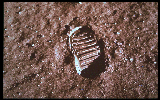Yes, the moon has a very thin atmosphere.
The moon's atmosphere consists mainly of neon, helium, and hydrogen.
Lunar Atmospheric Composition Experiment
The craters on the moon's surface are impact craters that formed when asteroids and meteorites hit the surface of the moon and exploded.
The moon is held by the gravitational pull of the earth.
The bright side of the moon always faces the sun.
The moon's gravitational pull on the earth is the force that affects the tides.
This force causes the earth to bulge on both sides; high tides occur where the bulge is greatest.

What role does the moon play in a lunar eclipse?
An eclipse occurs when the moon moves into the earth's shadow, or is in direct alignment with the earth and sun. During a Lunar eclipse, the sun and moon are positioned on opposite sides of the earth.

An eclipse occurs when the moon moves into the earth's shadow, or is in direct alignment with the earth and sun. During a Lunar eclipse, the sun and moon are positioned on opposite sides of the earth.

The moon is one quarter the size of the earth. It is also less dense.
As a result, the moon has one-sixth the gravity of the earth.
Neil Armstrong
